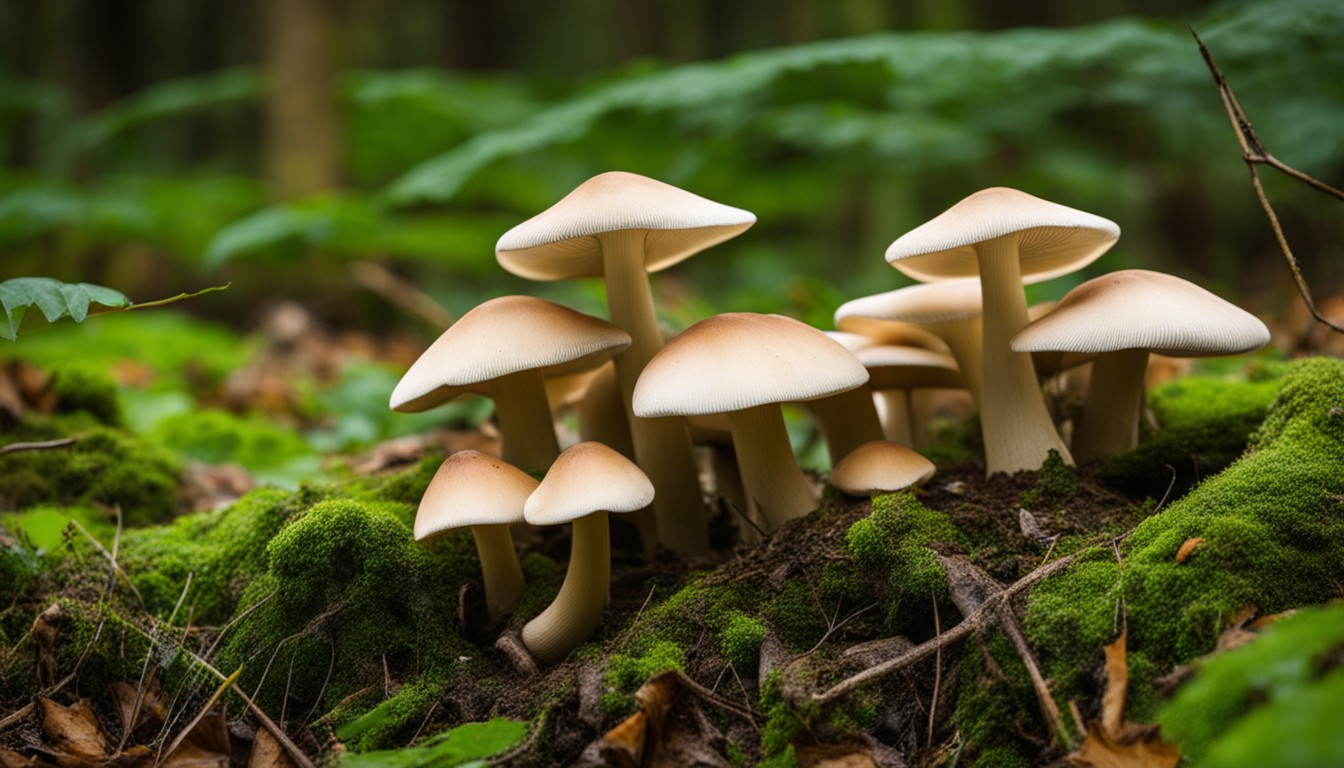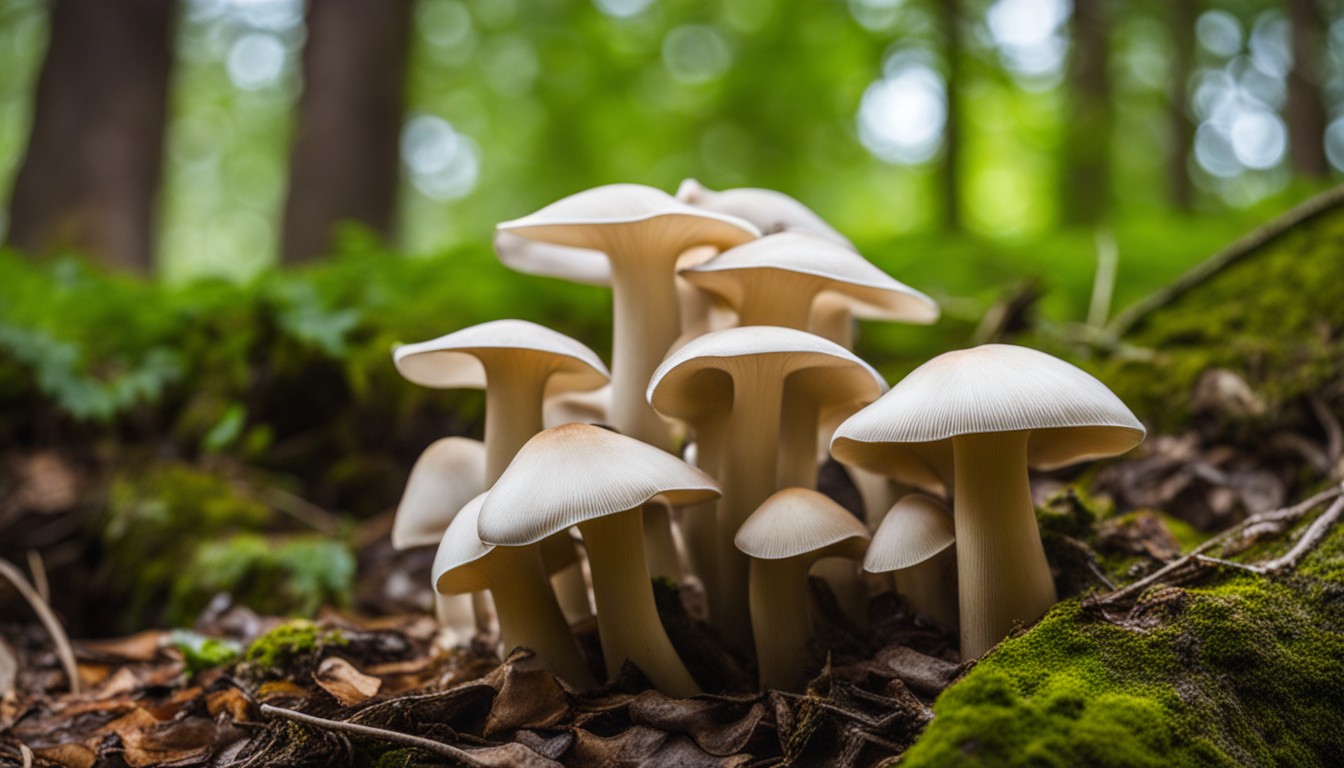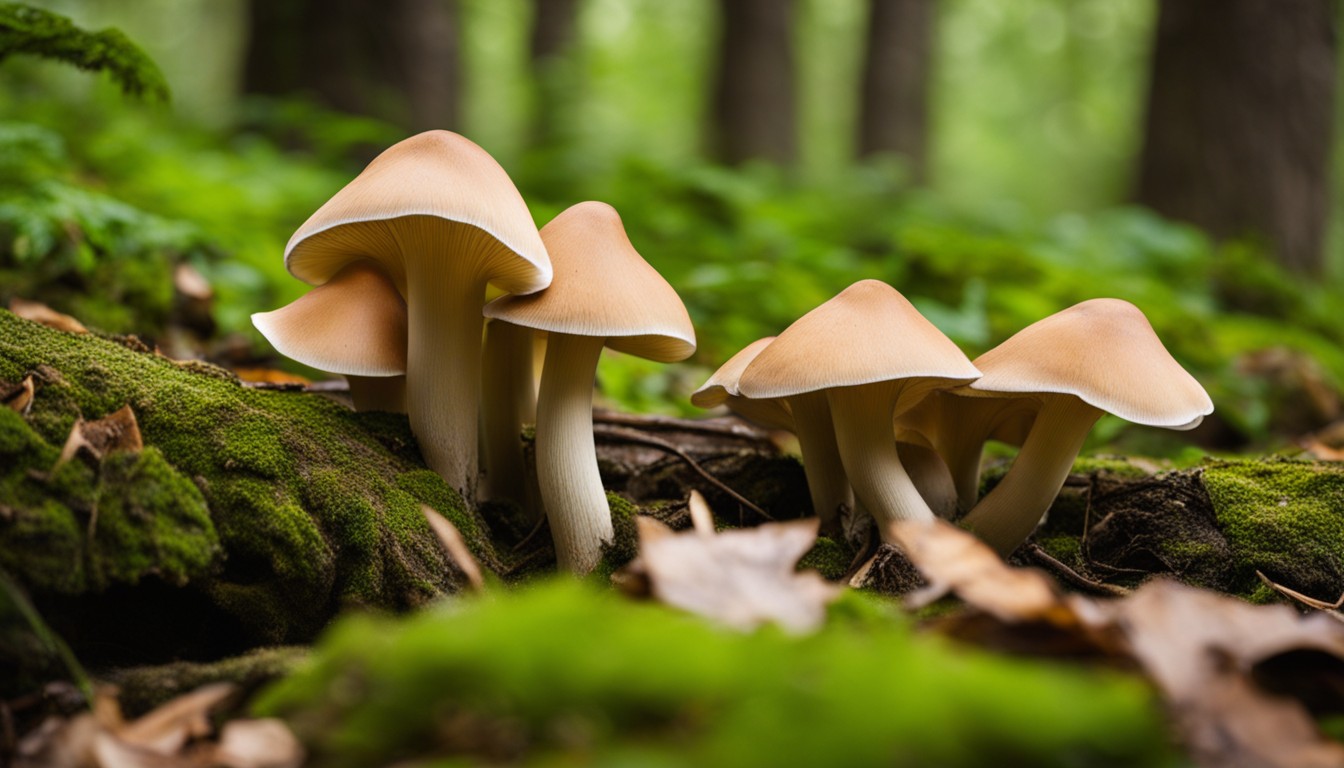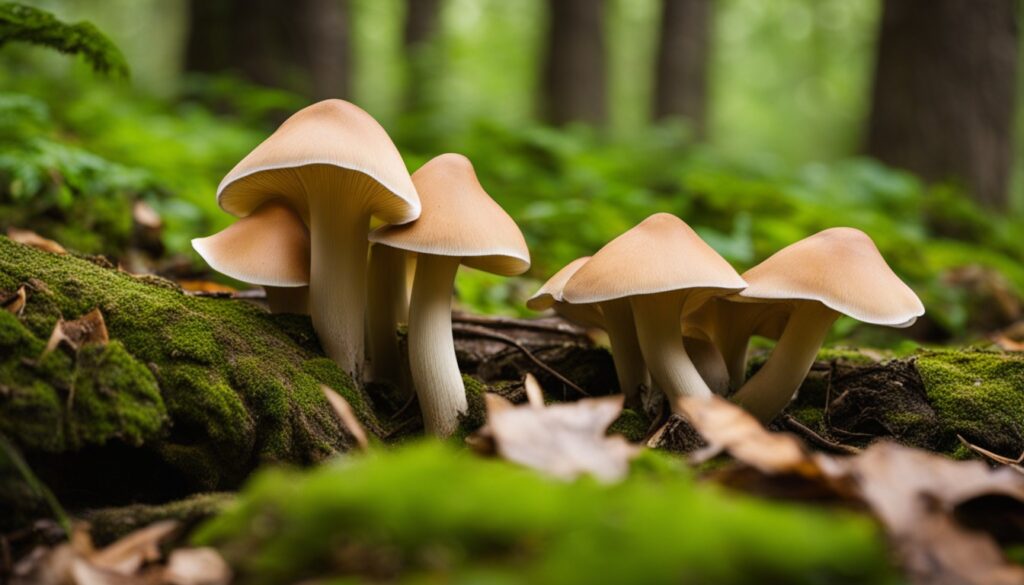Welcome to a journey through the diverse and enchanting world of mushrooms in Maryland. Situated in the heart of the Mid-Atlantic region, this state boasts a treasure trove of fungal species that thrive in its varied ecosystems. In this blog post, we will delve deeper into the captivating beauty and ecological significance of Maryland’s mushrooms.
Step into the lush forests and you’ll encounter a stunning array of mushroom species, each with its own unique characteristics and habitat preferences. From the iconic and widely recognized morel to the delicate and ephemeral coral fungi, Maryland offers a kaleidoscope of mushroom forms and colors to impress even the most discerning nature enthusiast.
But mushrooms are more than just pretty decorations on the forest floor. They play an essential role in the ecosystem as decomposers, breaking down organic matter and recycling nutrients back into the soil. By doing so, they contribute to the health and sustainability of Maryland’s forests, creating a harmonious balance between the living organisms and their environment.
In this blog post, we will not only showcase the stunning diversity of mushrooms found in Maryland but also provide tips and tricks on how to identify them safely. We will explore the key features to look for, such as cap shape, stem structure, and spore color, to help you confidently identify mushrooms during your walks in the woods. Remember, though, that mushroom identification requires knowledge and caution, as some species can be poisonous or inedible.
So, whether you’re a seasoned mycophile or a curious nature lover, get ready to embark on a mushroom-filled adventure through Maryland’s forests. Discover the hidden wonders that lie beneath the leaves and uncover the secrets of these fascinating fungi. By the end of this blog post, you’ll have a newfound appreciation for the vital role mushrooms play in the intricate web of life in Maryland.
What Makes Maryland a Fungal Haven
Maryland’s climate, characterized by ample rainfall and seasonal weather fluctuations, creates the perfect conditions for fungi prosperity. Alongside this, rich botanical diversity, from hardwood forests to marshy wetlands, offers a multitude of habitats catering to various mushroom species, making the state a true mycologist’s paradise.
The Ideal Climate for Mushroom Growth
Maryland’s four distinct seasons contribute significantly to mushroom diversity and proliferation. The warmer and wetter spring and fall periods create incubatory conditions, encouraging a plethora of different mushrooms to sprout.
Maryland’s diverse seasonal climate helps create optimal growth conditions, making it a hotbed for a wide variety of mushrooms across the year.
The range of temperatures, from cool winters to humid summers, paired with the state’s regular bouts of precipitation, result in a conducive growing environment. This interplay of climate variables ensures a steady supply of mushrooms throughout the year.
The Diversity of Mushroom Habitats
Unveiling the charm of Maryland are its multifaceted landscapes, a mix of dense forests, undulating mountains, fertile farmlands, and coastal marshes, all teeming with an array of fungal lives. It’s these varied ecosystems that serve as a fertile breeding ground, encouraging a rich growth of diverse mushroom species.
The breadth of Maryland’s ecosystems, from mountainous highlands to coastal wetlands, directly promotes its fungal richness. Every specific ecosystem, with its unique climatic conditions, nourishes specific mushroom species, further contributing to Maryland’s thriving fungal biodiversity.
Common Mushroom Species in Maryland
Maryland’s fungal landscape teems with common mushroom species, offering a rich canvas to explore for enthusiasts and mycologists alike. Acquaint yourself with this diverse ecosystem to unveil Maryland’s fungal voice.
The typical mushroom species in Maryland’s flora, with their distinct characteristics and habitats, are a roadmap to understanding the state’s ecological continuity. Recognizing these mushrooms are crucial steps towards appreciating Maryland’s biodiversity.
Morel Mushrooms: Maryland’s Spring Delicacy
Renowned as one of nature’s finest foods, the Morel mushroom adds a distinguished flavor to Maryland’s culinary scene. These mushrooms are a gourmet delicacy, their sought-after earthy taste and unique, honeycomb structure propelling food connoisseurs from across the region to chase their annual arrival enthusiastically.
- A highly anticipated event – the arrival of Morel season is celebrated through local gatherings and mushroom foraging excursions.
- Seize the opportunity – this culinary delight is largely available from early April to late May.
- A true Maryland tradition – Morel hunting is often seen as a cherished family tradition and cultural practice passed down through generations.
Hen-of-the-Woods: A Wild Treasure
The Hen-of-the-Woods, also known in Maryland as Maitake, graces the deciduous forests with a captivating life cycle while granting culinary and medicinal treasures.
- An annual mushroom, Hen-of-the-Woods develops large, overlapping clusters at the base of dead or dying hardwood trees in autumn.
- Known for its distinctive, fanning shape which resembles a hen’s ruffled feathers.
- It boasts sumptuous, chicken-like texture and nutty flavor, making it a sought-after ingredient in gourmet cuisine.
- Renowned in traditional Eastern medicine, it hosts potent immune-boosting properties and regulatory influences on blood sugar and pressure.
Chicken Mushroom: The Meaty Delight
The Chicken Mushroom, or Laetiporus sulphureus, offers a pleasingly strong, meat-like taste that makes it a favorite among Maryland’s culinary enthusiasts and mushroom foragers.
- Endeavor to pick immature, tender Chicken Mushrooms from their host tree without causing damage.
- Foraging from dying, or dead trees is advisable for both sustainability and food safety.
- Use a small, sharp knife to cut off the shelves of the Chicken Mushrooms; avoid pulling or tearing.
- Harvest only enough mushrooms for personal use, leaving some for wildlife and other foragers.
- When cooking, sauté Chicken Mushrooms in butter or oil for the best flavor extraction.
- Ideal for stir-fries, soups, and pasta dishes due to their robust, meaty flavor.
Poisonous Mushroom Species to Beware of
When foraging for mushrooms in Maryland, it’s crucial to recognize and steer clear of toxic species as careless interactions could lead to serious health threats. Certain types of these mushrooms, when ingested, can result in harmful effects ranging from mild upsets to lethal incidents.
- Amanita bisporigera, also known as Destroying Angel: Its consumption can lead to serious symptoms such as abdominal pain and even organ failure.
- Amanita phalloides, or the Death Cap Mushroom: Poisoning from this species can lead to liver failure and death.
- Galerina marginata, or the Funeral Bell: This small brown species harbors life-threatening toxins.
- Gyromitra esculenta, or the False Morel: Known for its brain-like appearance, this mushroom contains toxins that can cause dizziness, nausea, and in rare cases, death.
Edible and Medicinal Mushrooms of Maryland

Unearthing the potential of medicinal mushrooms native to Maryland, such as the Lion’s Mane, you’ll find a natural cognitive booster. Known as nature’s nootropic, this species represents a treasure trove of neuroprotective properties.
In the realm of gourmet delights, Maryland mycology presents unparalleled richness. Among the myriad edible varieties, Shiitake mushrooms stand out, both for their distinctive taste and nutritional make-up.
Moving further, the Reishi Mushrooms, natives of Maryland, are renowned for their immunity-enhancing capabilities, providing a natural defence against seasonal ailments.
Adding a fascinating touch to Maryland’s fungal flora, the Turkey Tail mushroom is touted as nature’s powerful antioxidant, contributing substantially to overall health and well-being.
Lion’s Mane: A Natural Cognitive Booster
Hailing from Maryland? Consider cultivating Lion’s Mane, a magnificent mushroom, which through its biologically active components, offers an array of health benefits. Ranging from neuron growth stimulation to enhancing cognitive functions, it’s no wonder this species is gaining popularity.
- The Lion’s Mane mushroom contains two unique compounds: erinacines and hericenones, known for their neuroprotective and neuroregenerative effects.
- These compounds have been linked to benefits such as improved memory, focus, and overall cognitive health.
- They potentially aid in the growth and repair of nerve cells, suggesting potential benefits for neurological diseases like Alzheimer’s.
- Lion’s Mane mushrooms can be cultivated on a small scale, creating an opportunity for local farming and commerce in Maryland.
- Growing conditions for Lion’s Mane are optimal in Maryland due to the state’s climate and topography.
Reishi Mushrooms: The Immunity Enhancers
Maryland’s Reishi mushrooms, also known as Ganoderma lucidum, have profound immune-boosting properties. They contain beta-glucans, a type of polysaccharide, which activates immune cells and helps to combat infections and diseases. This potent fungal species truly embodies the essence of healing.
Regular consumption of these remarkable mushrooms can manifest in numerous health benefits. They enhance the immune system, improve lung function, lower blood pressure, and provide anti-oxidative effects, reinforcing their status as immunity enhancers.
For Maryland residents keen on incorporating Reishi mushrooms into their diet, these are found in dried, powdered, or extract forms. Addition in teas, soups, or as a supplement would do wonders to bolster immunity.
However, while its usage comes with numerous benefits, it’s important to start slow and observe any side effects. Like any potent medicinal plant or fungus, each person’s reaction can vary widely. Seek professional advice as needed.
Thus, the use of Maryland’s immunity-enhancing Reishi mushrooms is an exemplary representation of the health benefits that mushrooms can offer. It is this symbiotic relationship with fungi that mankind has cherished for ages, and continues to do so today.
Shiitake Mushrooms: Culinary Delights and Health Benefits
Maryland’s Shiitake mushrooms are celebrated for engulfing palates with a rich, umami flavor and meat-like texture. Nutritionally striking, they are packed with proteins, fiber, and essential vitamins, asserting their place in many health-conscious diets.
Shiitake mushrooms are highly versatile, making a delightful addition to a myriad of snacks, entrees, and gourmet dishes, affirming their demand in homes and restaurants around Maryland, and beyond.
Cultivating Shiitake mushrooms provides a lucrative farming opportunity in Maryland, due to the climate’s congenial conditions and the mushroom’s nature of rapid proliferation in managed circumstances.
Numerous agricultural enthusiasts and small-scale farmers in Maryland thus invest in Shiitake mushroom cultivation, joining the worldwide trend towards locally-grown, nutritious and flavourful food.
Turkey Tail: Nature’s Powerful Antioxidant
Maryland naturally plays host to many Turkey Tail mushrooms, remarkable for their extraordinary antioxidant properties. This distinct species, found on dead logs and stumps, boasts vibrant concentric circles, mimicking a turkey’s tail feathers.
One of nature’s most powerful gifts, Turkey Tail carries potent antioxidant abilities, boosting the immune system and reducing inflammation. Its woody texture doesn’t lend itself well to culinary use but is commonly steeped in teas or taken as a nutritional supplement.
In Maryland, extensive research has delved into Turkey Tail’s cancer-fighting properties. Several compounds in these mushrooms, like Polysaccharide-K, are known for their potential to enhance cancer treatments and have been used with chemotherapy in Japan for years.
Studies continue in the local academic and medical fields, seeking more comprehensive understanding of Turkey Tail’s impact on varied types of cancer. The goal is to widen its usage across medicinal practices in Maryland and the rest of the United States.
The Turkey Tail mushroom in Maryland is not just a natural spectacle but also a promising source of health-enhancing compounds. As we continue to uncover its full potential, it becomes clear that the forest floors of Maryland serve as pharmacies in their own right.
Mushroom Foraging Tips and Safety Guidelines

In Maryland’s forests, sustainable mushroom foraging best practices include leaving smaller specimens to grow, collecting only a balanced amount from each species, and ensuring to never pull out but to carefully cut the mushrooms at the base to preserve the mycelium. These conservation measures help to maintain the fungal ecosystem’s vitality.
For newcomers to the Maryland mycology scene, essential mushroom foraging tools include a mushroom knife with an attached brush for cleaning, a wicker basket for carrying your finds allowing spores to spread, a local mushroom guidebook for accurate identification, and a GPS to prevent getting lost; all aiding to confidently start their fungi exploration journey.
Understanding Mushroom Anatomy and Identification
Spore print testing plays a pivotal role in the accurate identification of mushrooms. When foraging in Maryland environment, this knowledge tool helps differentiate between various fungal species by analyzing the color of the spores they release.
Consulting a detailed mushroom identification guide is integral during a foraging expedition. Such guides, tailored to the diversity of Maryland’s mushrooms, elaborate on various morphological characteristics including cap shape, stipe texture, and the nature of the gills.
Identifying the mushrooms commonly found in Maryland necessitates a good understanding of their morphological traits. A mushroom’s physical attributes such as color, size, and the pattern on its cap provide vital clues to species identification.
Thorough examination of mushroom’s structural parts also unveils key identification details. For instance, noticing whether gills are attached to the stem or free floating can aid in distinguishing between edible and poisonous varieties.
A holistic examination of mushroom anatomy is crucial for safe foraging, encompassing both the visible features and the microscopic spore details. Therefore, owning and using a magnifying glass and spore print kit is often recommended for enthusiasts in Maryland.
Locating Suitable Mushroom Hunting Grounds
Exploring Maryland’s diverse landscapes could lead you to an extraordinary variety of mushrooms. Understanding where specific mushroom types naturally thrive, such as forested areas, lawns, or decaying wood, could optimize your hunting success.
Forest habitats often support a rich assortment of fungal species. Dense woodland areas in Maryland, particularly those with an abundance of fallen logs and rich, moist soil, are typically prime spots.
Soil analysis is critical for successful mushroom hunting. Certain mushroom types prefer certain soil compositions. For example, shiitake mushrooms favoratively grow in soils rich in organic matter.
Remember, over-harvest is not sustainable and doesn’t support the ecosystem’s health. Therefore, it’s important to follow responsible foraging guidelines, ensuring enough fungi are left to guarantee future growth and spore distribution.
Ensuring Safety and Responsible Foraging
Adherence to the code of conduct for mushroom foragers is imperative. This code, which emphasizes respect for private lands, safe and sustainable harvesting techniques, and identification before consumption, ensures a thriving ecosystem and the well-being of the foragers.
Personal safety comes first when mushroom hunting. The right gear, including protective clothing and a trusty field guide, is crucial. When in doubt about identification, it is wise to leave the mushroom untouched.
A sense of responsibility must prevail among foragers. Beyond personal safety, the sustainability of fungal ecosystems depends on avoiding overharvesting, treading lightly, and respecting the rhythms of the natural world.
Capturing the Beauty of Maryland’s Mushrooms

Immerse yourself in the captivating charm of Maryland’s fungal biodiversity captured through the lens. The psychedelic swirls of Turkey Tail, the mystical silhouettes of Morels, or the intriguing clusters of Chicken Mushrooms offer an enchanting photographic journey.
From forest floor to kitchen door, the camera breathes life into Maryland’s exquisite edible mushrooms. Be it Shiitake’s radiant gills, Lion’s Mane’s cascading spines, or the intricate underbelly of Hen-of-the-Woods, every photograph unveils an intimate connection with nature.
The Art of Mushroom Photography
Mastering the play of light and shadow can dramatically enhance your mushroom photography. Harnessing natural sunlight, or using a reflector to direct soft light onto your subject can bring out the mystique essence of these fascinating organisms.
By juxtaposing soft shadows against brightly lit areas, you add depth to your images, creating a three-dimensional effect. Experiment with different lighting conditions to find the aesthetic that suits your style best.
Understanding the perfect aperture for mushroom photography is integral. Your aperture controls the depth of field and can bring the mushroom into sharp focus while gently blurring the background. Set your camera to aperture priority mode to maintain control.
This versatility allows the mushroom to be the star of your photograph, while the background complements it without detracting. Remember, practice makes perfect, so experiment with different aperture settings to discover what yields the most appealing results for your mushroom subject.
Tips for a Successful Mushroom Photo Shoot
Firstly, equipped with the right tools is paramount for a splendid mushroom photo shoot. A macro lens is crucial to capture intricate details. Moreover, don’t forget to carry a reflector and a sturdy tripod for stability and optimal lighting, respectively.
Lighting is a quintessential aspect of photography. Naturally diffused sunlight works best for mushroom shoots. However, avoid harsh sunlight as it may result in overloaded highlights and loss of detail. A slightly overcast day could be ideal.
To capture mushrooms in their prime, timing is crucial. The right time largely depends on the mushroom species. However, early mornings generally offer great light and dew-kissed mushrooms, adding a magical touch to the photos.
Perfectly timed shots in conjunction with favored weather conditions can truly make a difference. Ideally, aim for a day after rainfall as mushrooms thrive in moist conditions. This can lead to shots brimming with vibrant, healthy specimens.
Lastly, while mushroom photography is exhilarating, it’s essential to respect their natural habitat. Avoid damaging or unnecessarily moving mushrooms. Step lightly, move slowly, and leave the area as untouched as possible for future nature enthusiasts and foragers.
Sharing Your Mushroom Finds with the Community
Creating an online visual archive of Maryland’s mushrooms on platforms like Instagram, Facebook, or fauna monitoring sites is an enriching way to catalog diversity. Your unique observations can spark curiosity and encourage others to explore the fascinating world of fungi.
Participation in Maryland’s citizen science initiatives allows you to document and share your mushroom finds in a broader scientific perspective. Engaging with these platforms aids in conservation efforts and fosters a sense of community among fellow fungi enthusiasts.
Frequently Asked Questions
Welcome to our FAQ section, where we provide answers to commonly asked questions about mushrooms in Maryland.
Can I pick and eat mushrooms that I find in Maryland?
While mushroom foraging can be an exciting adventure, it is crucial to exercise caution and only consume mushrooms that you are absolutely certain are safe and edible. It is highly recommended to seek guidance from an experienced mycologist or attend a mushroom identification workshop to ensure your safety.
What are some notable mushrooms found in Maryland?
Maryland is home to a wide range of fascinating mushroom species. Some notable examples include the morel, oyster mushroom, chanterelle, and fly agaric. These mushrooms showcase the diversity and beauty of fungal life in the state.
Where can I go mushroom foraging in Maryland?
Maryland offers numerous natural areas and state parks that provide excellent opportunities for mushroom foraging. Some popular locations include Catoctin Mountain Park, Green Ridge State Forest, and Patapsco Valley State Park. However, it is important to research the regulations and obtain any necessary permits before embarking on your foraging expedition.
How can I learn to identify mushrooms in Maryland?
Learning to identify mushrooms can be a rewarding skill. To get started, consider joining a local mycological society or attending guided mushroom walks led by experienced experts. Additionally, there are reputable field guides and online resources available to help you familiarize yourself with the unique characteristics of different mushroom species.
Are there any poisonous mushrooms in Maryland that I should be aware of?
Yes, Maryland is home to several poisonous mushrooms, some of which can be deadly if ingested. It is crucial to avoid consuming any mushroom unless you are confident in its identification. Never rely solely on online resources or amateur identification, as misidentification can have severe consequences. When in doubt, consult with an expert or mycological society before consuming any mushroom.
Remember to always prioritize safety and responsible foraging practices when engaging with mushrooms in Maryland’s natural spaces.
Conclusion
As we traverse the splendor of nature’s fungal diversity in Maryland, it signals a journey of community enlightenment. The rich array of mushrooms unfolding in various habitats not only soothes the eye but also stirs curiosity, motivating individuals to delve into the fascinating world of mycology.
Concluding our journey through the mushroom exploration in Maryland, we are left in awe of the diversity and natural intricacy these species present. From edible to medicinal, and even to those perilous, the fungal kingdom in Maryland offers a captivating panorama that challenges, educates, and mesmerizes.
- Harness the diverse array of mushroom species for your culinary and medicinal purposes
- Educate yourself and others about the intricate structures and functions of different mushroom species
- Contribute to the conservation and responsible foraging of these natural treasures
- Share your findings, experiences, and photographs with the community to inspire further exploration

